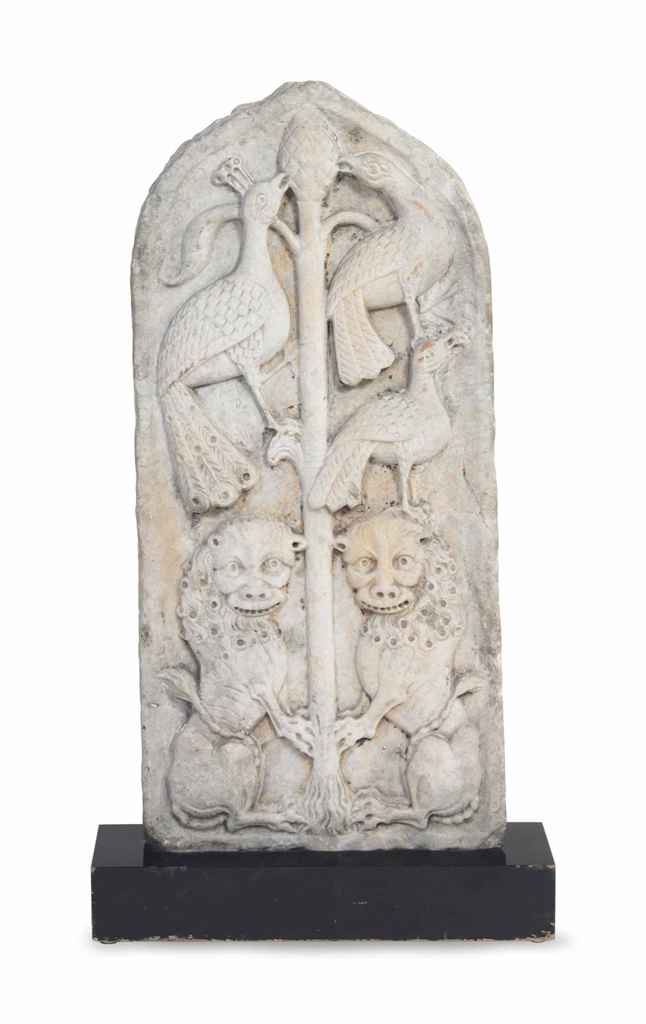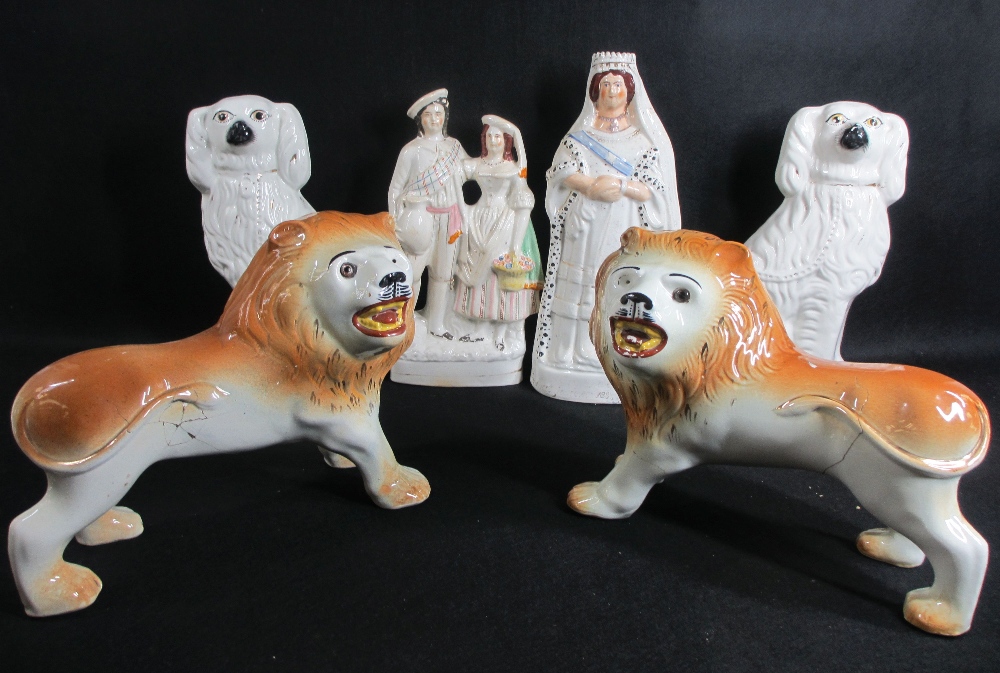A PAIR OF LIONS, CHINA MING-QING DYNASTY, 18TH-19TH CENTURIES 明清 十八至十九世纪 铜胎狮子一对 COPPIA DI LEONI, CINA, DINASTIA QING, SEC. XVIII-XIX in bronzo raffiguranti leoni divini. Alt.cm 81, base alt.cm 28 This extremely rare pair of lions is made of bronze, are cast seated on their haunches, the male with its right front paw resting on a brocade ball, the female with a lion cub beneath its left paw, each with powerful jaws. The seats are cast with extremely fine carvings of mountains and floral scrolls. The base is decorated with carved ornamentation, and the four legs are like auspicious clouds. It is worth noting that there are sixteen cubs on this pair of lions: fourteen on their shoulders and two near their left and right paws. Different from the fierce bronze lion image, this pair of lions present a loving image. Instead of facing up, the ears hang down meekly, which may mean listening carefully and not interfering in state affairs. There are three small bumps on the head, bells around the neck, wreaths, streamers and hydrangeas. And the mane, the beard and the tail velvet, which are exquisitely made and rare and beautiful, cover the sides of the head, chest, tail and claws. Its claws are strong but not fierce. The lion rolls the ball, the lioness teases the little lion, and the little lion has its claws in its mouth, which is charming and cute. It has the meaning of auspiciousness, happiness, children and good deeds. This pair of lions may be used in the harem. With the craftsmanship of bronze casting and carving, it can be traced back to the 18th-19th centuries of the Qing Dynasty. 这一对狮子以青铜铸成没有鎏金,神态逼真,造型生动,底座饰以镂刻纹饰,四足呈如意祥云状。守护狮子可能为御用,值得注意的是这对狮子身上有十六只小狮子:十四只在它们的肩膀上,两只分别在他们的左右爪子附近。与一贯凶猛青铜狮子形象不同,这对狮子的呈现出慈爱的形象。耳朵没有朝上,而是温顺地垂下,这或许是暗指慎重聆听,不干涉朝政。头上有三小一大突起,颈系铃铛,戴璎珞,口叼缎带似吼滚绣球。精致且做工罕见美丽的鬃毛,髯耏,和尾端绒,覆盖在首、胸、尾和爪子的两侧。其爪强壮但不显凶意,雄狮滚球,球上伏一小狮,雌狮逗弄小狮,小狮则口含雌狮爪,神情欢乐,娇憨可爱。似有吉祥喜庆,子嗣延绵,好事连连的寓意。这对狮子可能是供后宫所用的,凭青铜铸造和雕刻的工匠技术可推断,其年代可以追溯到中国清代十八至十九世纪。 LEONI GUARDIANI IMPERIALI IN BRONZO Le statue dei leoni guardiani si sono tradizionalmente poste di fronte ai palazzi degli imperatori cinesi ed alle loro tombe, ai templi ed ai palazzi degli alti ufficiali o nobili quale potente simbolo apotropaico. Come un ornamento tipico della tradizione cinese. Si tratta di uno stilema decorativo nato nell'ambiente del buddhismo cinese con intento apotropaico. I leoni sono rappresentati in una coppia che dovrebbe consistere di un maschio con una sfera intagliata tra gli artigli (a simboleggiare il dominio dell'imperatore sul globo terracqueo) e una femmina che trattiene un cucciolo giocoso supino sotto di lei (a simboleggiare il nutrimento). Come manifestazione di Yin (negativo) e Yang( positivo): la leonessa per lo Yin ed il maschio per lo Yang. Il maschio ha la zampa anteriore destra su di una sfera apparentemente di stoffa, chiamata "palla ricamata" ( 绣球 ). La femmina è essenzialmente identica ma ha un cucciolo sotto la zampa sinistra a rappresentare il ciclo della vita. Simbolicamente, la leonessa protegge gli abitanti (l'anima vivente interna) e il maschio protegge la struttura (gli elementi materiali esterni) dell'edificio che entrambi sorvegliano. La coppia di leoni presentata in asta è fusa in bronzo con basi decorate a incisione e poggianti su piedi a forma di nuvole Ruyi. A causa dell'elevato costo di questi materiali e del lavoro richiesto per produrli, l'uso dei leoni custodi era probabilmente riservato alla famiglia imperiale, come simbolo di ricchezza e potenza, e non solo. In questo caso, degni di nota si presentano sedici cuccioli sui corpi della coppia: quattordici sulle spalle e due vicino alle zampe. A differenza della più nota rappresentazione dei leoni bronzei come feroci, questa coppia è caratterizzata da un’immagine che esalta la dimensione famigliare e affettiva. Le orecchie non sono rivolte verso l'alto, ma si abbassano docilmente, forse allusione alla discrezione nell’ascolto e al non interferire negli affari di corte. Si ravvisano protuberanze ossee
A PAIR OF LIONS, CHINA MING-QING DYNASTY, 18TH-19TH CENTURIES 明清 十八至十九世纪 铜胎狮子一对 COPPIA DI LEONI, CINA, DINASTIA QING, SEC. XVIII-XIX in bronzo raffiguranti leoni divini. Alt.cm 81, base alt.cm 28 This extremely rare pair of lions is made of bronze, are cast seated on their haunches, the male with its right front paw resting on a brocade ball, the female with a lion cub beneath its left paw, each with powerful jaws. The seats are cast with extremely fine carvings of mountains and floral scrolls. The base is decorated with carved ornamentation, and the four legs are like auspicious clouds. It is worth noting that there are sixteen cubs on this pair of lions: fourteen on their shoulders and two near their left and right paws. Different from the fierce bronze lion image, this pair of lions present a loving image. Instead of facing up, the ears hang down meekly, which may mean listening carefully and not interfering in state affairs. There are three small bumps on the head, bells around the neck, wreaths, streamers and hydrangeas. And the mane, the beard and the tail velvet, which are exquisitely made and rare and beautiful, cover the sides of the head, chest, tail and claws. Its claws are strong but not fierce. The lion rolls the ball, the lioness teases the little lion, and the little lion has its claws in its mouth, which is charming and cute. It has the meaning of auspiciousness, happiness, children and good deeds. This pair of lions may be used in the harem. With the craftsmanship of bronze casting and carving, it can be traced back to the 18th-19th centuries of the Qing Dynasty. 这一对狮子以青铜铸成没有鎏金,神态逼真,造型生动,底座饰以镂刻纹饰,四足呈如意祥云状。守护狮子可能为御用,值得注意的是这对狮子身上有十六只小狮子:十四只在它们的肩膀上,两只分别在他们的左右爪子附近。与一贯凶猛青铜狮子形象不同,这对狮子的呈现出慈爱的形象。耳朵没有朝上,而是温顺地垂下,这或许是暗指慎重聆听,不干涉朝政。头上有三小一大突起,颈系铃铛,戴璎珞,口叼缎带似吼滚绣球。精致且做工罕见美丽的鬃毛,髯耏,和尾端绒,覆盖在首、胸、尾和爪子的两侧。其爪强壮但不显凶意,雄狮滚球,球上伏一小狮,雌狮逗弄小狮,小狮则口含雌狮爪,神情欢乐,娇憨可爱。似有吉祥喜庆,子嗣延绵,好事连连的寓意。这对狮子可能是供后宫所用的,凭青铜铸造和雕刻的工匠技术可推断,其年代可以追溯到中国清代十八至十九世纪。 LEONI GUARDIANI IMPERIALI IN BRONZO Le statue dei leoni guardiani si sono tradizionalmente poste di fronte ai palazzi degli imperatori cinesi ed alle loro tombe, ai templi ed ai palazzi degli alti ufficiali o nobili quale potente simbolo apotropaico. Come un ornamento tipico della tradizione cinese. Si tratta di uno stilema decorativo nato nell'ambiente del buddhismo cinese con intento apotropaico. I leoni sono rappresentati in una coppia che dovrebbe consistere di un maschio con una sfera intagliata tra gli artigli (a simboleggiare il dominio dell'imperatore sul globo terracqueo) e una femmina che trattiene un cucciolo giocoso supino sotto di lei (a simboleggiare il nutrimento). Come manifestazione di Yin (negativo) e Yang( positivo): la leonessa per lo Yin ed il maschio per lo Yang. Il maschio ha la zampa anteriore destra su di una sfera apparentemente di stoffa, chiamata "palla ricamata" ( 绣球 ). La femmina è essenzialmente identica ma ha un cucciolo sotto la zampa sinistra a rappresentare il ciclo della vita. Simbolicamente, la leonessa protegge gli abitanti (l'anima vivente interna) e il maschio protegge la struttura (gli elementi materiali esterni) dell'edificio che entrambi sorvegliano. La coppia di leoni presentata in asta è fusa in bronzo con basi decorate a incisione e poggianti su piedi a forma di nuvole Ruyi. A causa dell'elevato costo di questi materiali e del lavoro richiesto per produrli, l'uso dei leoni custodi era probabilmente riservato alla famiglia imperiale, come simbolo di ricchezza e potenza, e non solo. In questo caso, degni di nota si presentano sedici cuccioli sui corpi della coppia: quattordici sulle spalle e due vicino alle zampe. A differenza della più nota rappresentazione dei leoni bronzei come feroci, questa coppia è caratterizzata da un’immagine che esalta la dimensione famigliare e affettiva. Le orecchie non sono rivolte verso l'alto, ma si abbassano docilmente, forse allusione alla discrezione nell’ascolto e al non interferire negli affari di corte. Si ravvisano protuberanze ossee














Try LotSearch and its premium features for 7 days - without any costs!
Be notified automatically about new items in upcoming auctions.
Create an alert